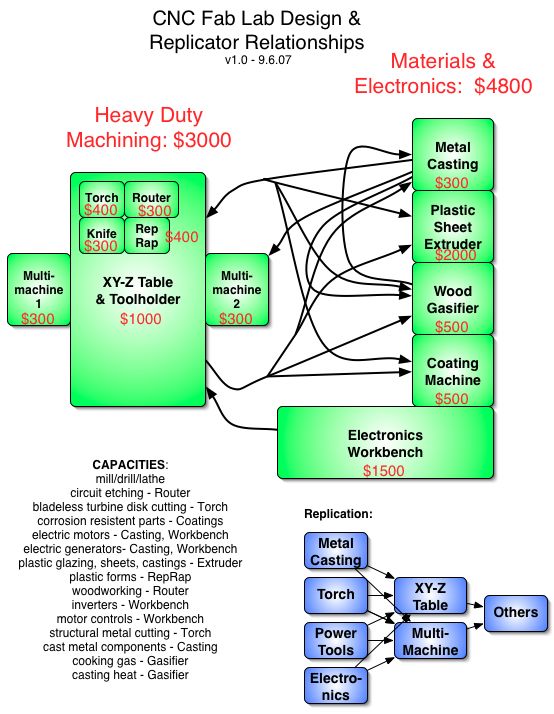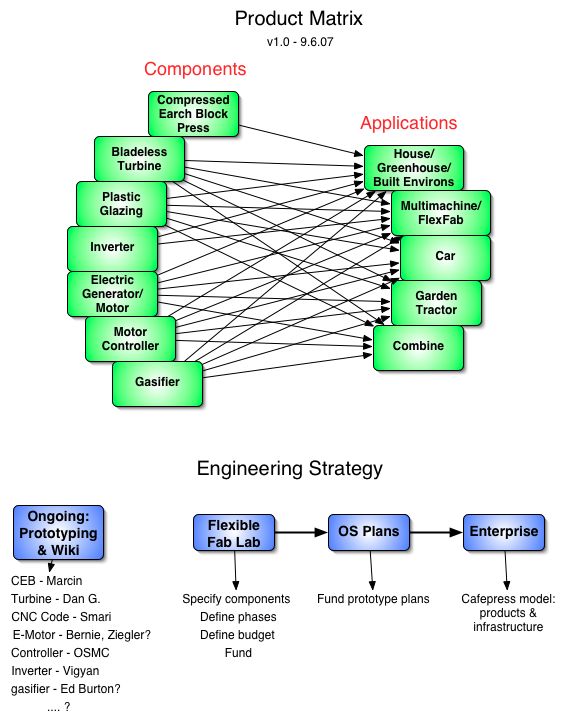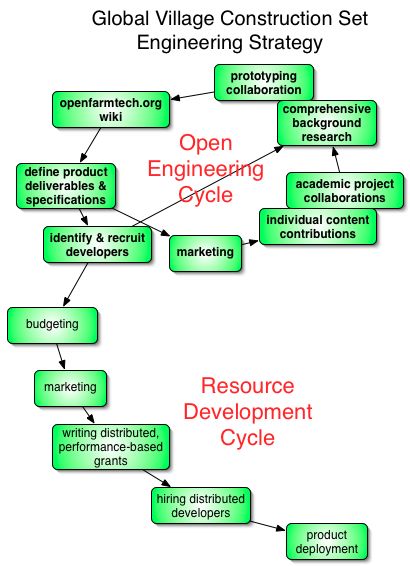Main Page 2
![]() It has been suggested that the text below be merged into (added to) the [[::Main Page|Main Page]] page. (Discuss)
It has been suggested that the text below be merged into (added to) the [[::Main Page|Main Page]] page. (Discuss)
(continued from Main Page
The rest of this page is about the Global Village Construction Set and the plan for how it will be implemented by Open Source Ecology.
- HABITAT: CEB Press - Sawmill - Living Machines - Modular Housing Units
- AGROECOLOGY: LifeTrac Multi Purpose Tractor - MicroTrac - Power Cube - Agricultural Spader - Agricultural Microcombine - Hammer Mill - Well Drilling Rig - Organoponic Raised Bed Gardening - Orchard and Nursery - Modular Greenhouse Units - Bakery - Dairy - Energy Food Bars - Freeze Dried Fruit Powders
- ENERGY: Pyrolysis Oil - Babington Burner - Solar Combined Heat Power System - Steam Engine Construction Set - Solar Turbine - Electric Motors/Generators - Inverters & Grid Intertie - Batteries
- FLEXIBLE INDUSTRY: Lathe - Torch Table - Multimachine & Flex Fab - Plastic Extrusion & Molding - Metal Casting and Extrusion
- TRANSPORT: Open Source Car
- MATERIALS: Bioplastics
Global Village Construction Set
In effect, the 28 products serve as a sufficient, but incomplete, basis for a Global Village Construction Set (GVCS). We are talking about resettling land to become its stewards - whether in locations already settled or on frontiers.
Economy creates culture and culture creates politics. Politics sought are ones of freedom, voluntary contract, and human evolution in harmony with life support systems. Note that resource conflicts and overpopulation are eliminated by design. We are after the creation of new society, one which has learned from the past and moves forward with ancient wisdom and modern technology.
Furthermore, it should be noted that this is a real experiment, and product selection is based on us living with the given technologies. First, it is the development of real, economically significant hardware, product, and engineering. Second, this entire set is being compiled into one setting, and land is being populated with the respective productive agents. The aim is to define a new form of social organization where it is possible to create advanced culture, thriving in abundance and largely autonomous, on the scale of a village, not nation or state.
See a video presentation on the first year at Factor e Farm and the GVCS below from 2007-2008, or the part on the GVCS here. The Distillations videos review the progress of 2008-2009.
You can also view the GVCS slide show presentation for more information.
Product Selection Criteria
The selection of 28 products is based on
- Availability of a land or facility base
- Essential contribution to an infrastructure for living and working
- Essential goods and services of wide use and large markets
- Provision of a robust village economy and sufficient surplus for further developments
- Generative nature of the product, thus promoting self-replication of the village
- Selection of a widely applicable and sufficient, but not complete, range of economic activity to support a community
- Viability of a community on a village scale, perhaps 100 people, but as few as 2 or as many as sustained by the land base
Collaborative Development Process
The open development process involves global contributions of content to a rigorously defined process for developing, deploying, and improving the Global Village Construction Set. The rigor lies in a template that guides the development through all the necessary theoretical and practical aspects of deploying a given product. The same template, or process, is adapted to deliver all the products of the Construction Set. The template starts with product definition and ends with economically significant models of production.
If you are interested in contributing to this wiki, your first step is a quick debriefing on the issues we are trying to solve. Please bring yourself up to speed with the background, project status, and action items as described in the "Development Template" below. Once you read up on the current work and key issues being considered, you are in a position to make meaningful contributions consistent with the goals and progress of the overall project.
With a sufficient pool of technically-skilled collaborators, we aim to deploy the complete Global Village Construction Set in 3 years, starting at the latter part of 2007. The result is a formula for building your own village - whether you pursue our open source designs and business models yourself or with a group, or buy infrastructure components from providers, or buy an entire turnkey village infrastructure according to proven specifications. From that point, all you need is land and people to populate your village, and you are on your way to freedom.
Enterprise Community Contract
We are proposing the formation of Global Villages in the form of productive enterprise communities that strive for unprecedented quality of life:
- material abundance
- freedom from bureacracy and unnecessary activity
- total focus on one's true interests
For our particular OSE prototype implementation, we are interested in the following general essence of an Enterprise Community Contract:
- 2 hours of productive activity daily, such that 100% of the community's food, energy, housing, transportation, and technology essentials are produced for subsistence, with surplus production for market
- Agriculture base follows permaculture design, and includes production of water soluble organic fertilizer, orchard, nursery, and crops, as well as certain food processing and value added propositions
- Flexible fabrication produces advanced technologies at the cost of materials
- Cost of living is reduced dramatically, from $20,000/year in the industrialized world, to negligible income requirements, under the assumption of high-tech self-providing
- Each participant undertakes a study program of full stewardship of the community, including:
- Agricultural production capacity
- Technological literacy to operate and maintain flex fab equipment and other machinery
- Numeracy to facilitate design
- Study of the mind and body to expand one's consciousness, skills, and abilities, and to disseminate such human augmentation widely towards eliminating mind control of the masses
- Entry of new people can be negotiated by the new participants providing skills and productive contribution to the community
- Beyond the 2 hour requirement, participants follow a research lifestyle to promote further development of the community or of the greater world
Enabling Technology - Salient Features of Technology Base
Without going into details, the main features for the comprehensive technology base are:
- Hybridization of power devices - decoupling of power source from the working unit in order to produce electrical drive is a formula for increasing integrated efficiency of electromechanical devices such as electric vehicles, tools, heavy equipment, etc. For example, the hybrid car decouples the engine from its wheels by using an electrical generator to feed electric wheel motors. Note that this eliminates the clutch, transmission, crank case and its oil, differential, drive train, and other parts, and replaces these items with electric wire from the generator to electric motor. This is a huge efficiency leap, one in fuel efficiency, and two, in eliminating billions of dollars of industry which is outdated today due to the hybridization option. As such, we can talk of complex machines with huge simplification, assuming easy access to infinitely scaleable and controllable, low cost electric motors (these do not exist today). For example, we can envision an agricultural combine where each moving part is powered by its own electric motor - producing a leap in simplification and maintenance of the overall machine - as all belts, pulleys, gears, and other power transmission components driven by a single engine - are all replaced by electric wire. One can point to many examples where such strategy would provide leapfrog advance in device simplicity and maintenance.
- Solar turbine power generation including heat storage - look at Solar Turbine CHP System
- Open source fab lab - combine and expand the [1] with xyz table as in RepRap (http://reprap.org/), and you can envision a robust fabrication device that integrates open source computer aided design (CAD) and computer aided manufacturing (CAM). This device would perform a large variety of machining and fabrication operations, and would be producible at the cost of materials if metal casting is available. When deployed, we are talking of producing any advanced object or device at the cost of materials. Would you like to fabricate an electric motor for your personal transport vehicle? Here, I'll email you a file to make on your local village fabber. In practice, one could conceptualize a single or several Multimachines, with their milling-drilling-lathing functions, surrounding an xyz motion platform with interchangeable heads. These heads could include acetylene torch attachment, plasma cutter, CO2 laser, router, hot wire, or additive heads such as a plastic extruder found in RepRap. This overall fab lab concept could start with a basic machine such as the Multimachine, with computer controls and table added in time. As such, this is a realistic proposition - with supporting open source knowhow with significant advancement already available. This propels civilization to new levels of decentralized material prosperity, and implies significant reduction of resource conflicts, especially if material feedstocks are sourced locally - as in the next point.
Here is an initial Fab Lab design:

Here is a sample Product Matrix that falls right out of Fab Lab capacities:
- Production of local feedstocks-
- Wood and structural masonry compressed earth block (CEB) for construction - produced from on-site trees and soils
- Compressed Fuel Gas for cooking or melting metal - gas produced from trees
- Bioplastics - such as cellophane from trees
- Biofuels - Fuel Alcohol in temperate zones, palm oil in tropical zones
- Industrial detritus (waste materials) processing - includes Metal Casting and Extrusion or Plastic Extrusion & Molding
- Aluminum Extraction From Clays
Sample Scenario
Imagine a village with buildings of dirt (CEB) with year-round greenhouses (sawmill, CEB, bioplastics from local trees), with all facility energy produced by a solar turbine, where people drive hybrid cars with car bodies (bioplastics) made from local weeds, with critical motors and metal structures (aluminum) extracted from on-site clay, which are fueled by alcohol produced on-site, on a wireless network linked to the greater world. That's just a sampling of the technology base. Food, energy, housing sufficiency. There are no poor among us - because we are all evolving human beings and farmer scientists.
Development Template
Open Engineering Strategy
See Open Engineering for more details.
Here is a diagram of the engineering development strategy:
Definition of Open Source Hardware and OSE Specifications
See the updated entry for OSE Spec here.
We like to be clear about the meaning of open, or open source,' as used in this work for items of physical production. By open source, we mean documented to the point where one may replicate a given item, without even consulting with the developers. To us, this embodies the most complete form of documentation possible, where sufficient detail is provided to enable independent replication. This is open source embodied in OSE Specifications. Other features of OSE Specificationsare:
- Freely downloadable documentation
- DfD, lifetime design
- Simplicity and low cost are of prime importance
- Replaceable components
- Modular Design
- Scaleability
- Localization
- Level 1 - product fabrication or production is local
- Level 2 - material sourcing is local
- Product evolution - phases and versions are pursued
- Concrete Flexible Fabrication mechanism exists for others to purchase the product at reasonable cost
- Open franchising - replicable enterprise design is available, and training exists for entrepreneurs
Thus, these features are meant to promote liberatory technology - open, replicable, essential, optimal, and ecological goods and services for humankind living in harmony with natural life support systems.
Working Assumptions
Here is a partial list of assumptions that we are making as we go about the development work of this wiki. These assumptions help one to understand our motivations and approach.
- Underlying dynamics of human civilizations are related to peoples' resource base. The resource base, and its control through the control of other humans, is the feedstock for power and its accumulation. Resource conflicts occur because people have not yet learned to manage the global resource base without stealing from others. In other words, society dynamics have not transcended the brute struggle for survival. As a society, we remain on the bottom steps of Maslow's pyramid. Transcending resource conflicts by creation of abundance, on the unit scales of few hundreds to few thousands of humans, is a present possibility under the assumption of open source knowledge flows and advanced technical capacities for material production.
- Today, most humans are controlled not by a commercial force (armies) but by information and social engineering that feeds the commerce itself. Understanding means of social control; understanding the mechanics of one's mind, body, and spirit; learning to discern mechanics of mind control and propaganda as they are used in New World Order agendas; and applying learnings to meditation, expansion of consciousness, and evolution of one's awareness and powers are all crucial if civilization is to escape the control of commercialism and is to give up its dependence on a centralized, planned economy.
- Said propaganda and conditioning has successfully removed the notion of self-sufficiency as a viable means of livelihood. Most people are afraid of self-sufficiency and consider it a return to the stone age. Most people cannot envision that advanced civilization can be created in small (100-1000 person), self-sufficient, highly skilled communities. Furthermore, most people do not realize that it is possible to educate, skill, and evolve human beings such that an integrated, self-sufficient lifestyle option that promotes advanced civilization on a small scale of human organization is created. It it possible to achieve this level of excellence if people are taught real knowledge and wisdom, as opposed to undergoing global workforce training.
- Education curricula have typically deleted practical applications deliberately, to produce subjects of the global workforce. If education is reinstated â then self-sufficiency will emerge as a natural option.
- Self-sufficiency is not an antisocial behavior, but a means to full individual and community accountability for resource conflicts, foul politics, and other corruptions of large-scale endeavors. (review works of Gandhi, Schumacher, Fuller) Self-sufficiency is a means to highest quality life â by definition, one is in control of one's destiny when one is self-sufficient. The assumption of self-sufficiency is that its practitioners must be highly skilled, and not products of centralist education.
- By self-sufficient, we mean in full control of providing one's needs. Note that self-sufficiency refers to needs - those things that allow one to survive in absolute health - and not wants. Self-sufficiency does not imply a solo, isolationist endeavor. Self-sufficiency may be accomplished with the help of as many people as it is possible to maintain full accountability, transparency, and sound ethics within that group. This group may be dispersed globally. Historically, sociology of human settlements has shown that this scale of self-sufficiency is a few hundred people. (see E.F. Schumacher; other references)
- The State promotes well-paid incompetence, largely through specialization, such that subjects produce sufficient surplus to pay for their own oppression.
- Education, media, and social engineering programs have subjugated human integrity to passive consumerism, with its related problems (resource conflicts, loss of freedom such as wage slavery). The only way out of this is creating a framework within which humans can prosper: provision of true education, learning of practical skills, stewardship of land, advanced technology for the people, and open access to economically significant knowhow.
- Import substitution is reducing dependence on external feedstocks and replacing them with local ones. People in control of their resources control their own destiny. Thus, to localize the essential parts of an economy completely is the prime formula for social stability. Localization should not be considered a struggle, but merely a possibility. It is a possibility that is not recognized because most people, as specialists, lack integrated technical literacy and skills that make a local economy feasible.
Products
Here is a brief description of the technologies that we are developing.
CEB Press
CEB - Compresssed Earth Block press - regarded as the highest quality natural building method; also used in upscale housing; does not require curing - so may be built continuously; lends itself to 100% onsite building material sourcing; excellent thermal, acoustic, and strength; aka structural masonry. Also usable in fences, cisterns, road paving, Usable for ovens in a bakery, pond dams, thermal storage cisterns, silos. Used for barns, dairy plant, bakery building, additinal housing, greenhouses, etc. I would go so far as that could be the secret weapon of the entire operation. Other connections in diagram: requires soil to be pulverized, which may be done with the agricultural spader. May be used for building raised beds, modular building and greenhouse units. High value flex fab enterprise opportunity for any entrepreneur interested in fabrication of machine- huge profits are possible, because other CEBs are expensive ($25k for one of 3-5 brick/minute performance). Livelihood opportunity for independent builders. Requires as little as 1 person to operate. OSE design is based on power from tractor hydraulics - where the tractor is a general tool that can supply power to a large number of devices. Output with 2 people - a 6 foot high round wall, 20 feet in diameter, 1 foot thick, can be built in one 8 hour day. Fabrication is simple - after metal is cut - a drill press is required for drilling holes for design-for-disassembly structure. Welding is required in a few places where bolting is not practical, such as the hopper box. Summary: a high performance, rapid, semi-skilled building technique, which lends itself as a building method for creating advanced civilizations. Lifetime design.


